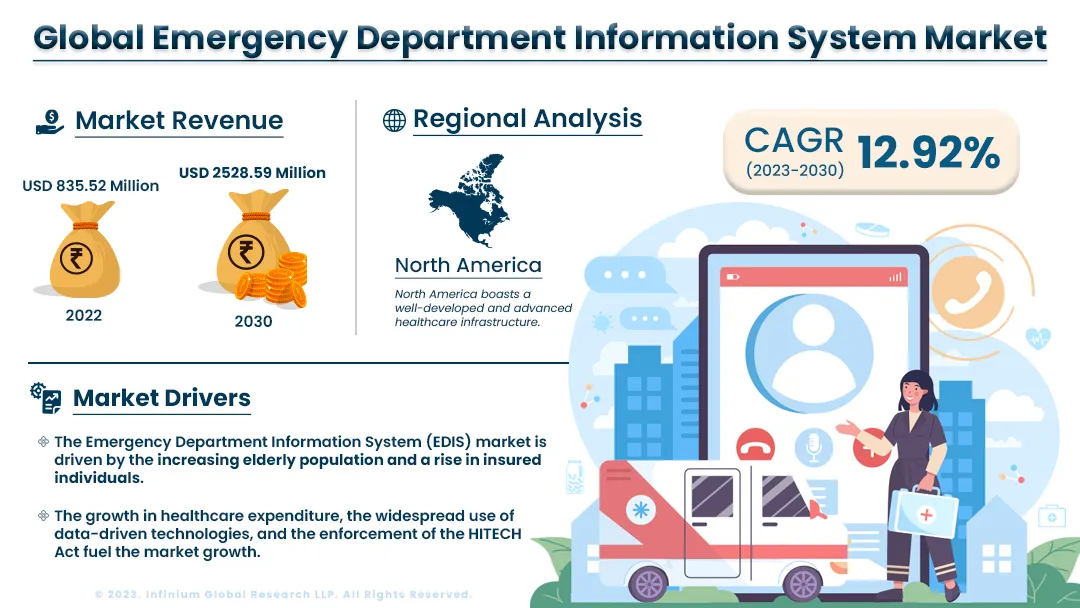Emergency Department Information System Market (Application - Computerized Provider Order Entry, Clinical Documentation, Patient Tracking & Triage, E-prescribing, and Others; Deployment - On-premise, and On Cloud Basis): Global Industry Analysis, Trends, Size, Share and Forecasts to 2030
A recent report published by Infinium Global Research on emergency department information system market provides in-depth analysis of segments and sub-segments in the global as well as regional emergency department information system market. The study also highlights the impact of drivers, restraints, and macro indicators on the global and regional emergency department information system market over the short term as well as long term. The report is a comprehensive presentation of trends, forecast and dollar values of global emergency department information system market.
Market Insight:
The Emergency Department Information System (EDIS) Market is relevant to the healthcare information technology sector specializing in software solutions designed to manage and automate emergency department operations within hospitals and healthcare facilities. These software systems are customized to address the specific requirements and challenges faced by emergency departments, where timely and critical patient care is delivered. EDIS software aids in monitoring patients from their arrival at the emergency department, encompassing the recording of patient demographics, chief complaints, and triage status. EDIS systems often incorporate tools to assist in the triage process, enabling healthcare providers to prioritize patients based on the severity of their conditions. The primary objective of an EDIS is to improve the efficiency and quality of care in emergency departments by ensuring that vital information is readily accessible, streamlining patient care procedures, and ensuring accurate and easily accessible documentation. These systems empower healthcare providers to make faster and more well-informed decisions in emergency situations, ultimately resulting in enhanced patient outcomes.
The Emergency Department Information System (EDIS) market is driven by the increasing elderly population and a rise in insured individuals. The aging demographic requires more frequent healthcare, especially in emergency situations, leading to a surge in emergency department visits. This necessitates the adoption of effective EDIS solutions to handle the increased patient load. Furthermore, the growth in healthcare expenditure, the widespread use of data-driven technologies, and the enforcement of the HITECH Act are contributing to the expansion of the EDIS market. Rising healthcare costs are often associated with higher patient numbers, driven by factors like aging demographics and the prevalence of chronic diseases, placing greater demands on emergency departments. The HITECH Act encourages the interoperability of Electronic Health Records (EHR), ensuring that patient data can be efficiently shared and accessed across various healthcare settings, a critical capability during emergencies. However, a shortage of skilled healthcare workers, substantial upfront and ongoing costs, and concerns about patient safety may act as barrier to market growth. Although, the increasing adoption of telemedicine and virtual healthcare services presents promising opportunities for the growth of the EDIS market.

North America is projected to hold the most significant market share in the upcoming forecast period. North America boasts a well-developed and advanced healthcare infrastructure. This includes numerous hospitals, healthcare systems, and emergency departments. The existing healthcare infrastructure provides a strong foundation for the adoption of EDIS solutions. Moreover, North America has a history of early technology adoption in the healthcare sector. Healthcare organizations in the region are often quick to embrace innovative technologies that enhance patient care, improve efficiency, and comply with regulatory requirements. Meanwhile, APAC is emerging as the fastest-growing region in the upcoming forecast period. APAC has a rapidly growing population, which directly correlates with an increased demand for healthcare services, including emergency care. As the population expands, so does the number of people requiring medical attention, contributing to higher patient volumes in emergency departments.
Report Scope of the Emergency Department Information System Market:
| Report Coverage | Details |
|---|---|
| Market Size in 2022 | USD 835.52 Million |
| Market Size by 2030 | USD 2528.59 Million |
| Growth Rate from 2023 to 2030 | CAGR of 12.92% |
| Largest Market | North America |
| No. of Pages | 180 |
| Market Drivers |
|
| Market Segmentation | By Application, and By Deployment |
| Regional Scope | North America, Europe, Asia Pacific, and RoW |
Segment wise revenue contribution in the global emergency department information system market
The report on global emergency department information system market provides a detailed analysis of segments in the market based on Application, and Deployment.
Segmentation Based on Application
· Computerized Provider Order Entry
· Clinical Documentation
· Patient Tracking & Triage
· E-prescribing
· Others
Segmentation Based on Deployment
· On-premise
· On Cloud Basis
Company Profiled:
· Oracle
· EPOWERdoc
· MEDHOST
· Medical Information Technology, Inc.
· Medsphere Systems Corporation
· The T System, Inc.
· Wellsoft (acquired by Medsphere Systems Corporation)
· MCKESSON CORPORATION
· evident.com
· Allscripts/Veradigm
Report Highlights:
The report provides deep insights into demand forecasts, market trends, and micro and macro indicators. In addition, this report provides insights into the factors that are driving and restraining the growth in this market. Moreover, The IGR-Growth Matrix analysis given in the report brings an insight into the investment areas that existing or new market players can consider. The report provides insights into the market using analytical tools such as Porter's five forces analysis and DRO analysis of the emergency department information system market. Moreover, the study highlights current market trends and provides forecasts from 2023-2030. We also have highlighted future trends in the market that will affect the demand during the forecast period. Moreover, the competitive analysis given in each regional market brings an insight into the market share of the leading players.
